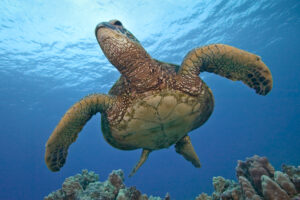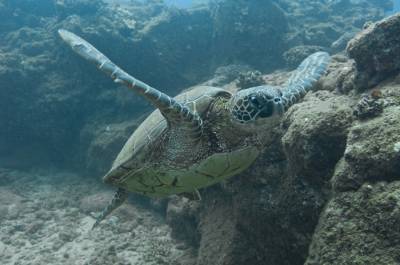Your cart is currently empty!
Find Some Separation

Can you remember the first time you saw a shark, manta ray, dolphin, turtle, spotted eagle ray, or any other animal you might think of as Mr. Big? Maybe you have not enjoyed an experience like that yet. But keep diving for a while, and you will.

If you are like many underwater photographers, when you get your first opportunities to photograph Mr. Big, you will find yourself so fixated on your subject that you fail to see anything else around it. Failing to consider the background is a very common pitfall for underwater shooters, especially when photographing animals that are large enough to make your adrenaline flow a little more freely.
After all, it’s a perfectly understandable, natural reaction to look at a big animal when you encounter it. I mean, who sees a shark and then looks away to see if they can find a more compelling subject?
A lot of things go into creating a compelling shot of Mr. Big, and one of those factors is doing what you can to help your subject stand out, or visually “jump out”, of your frame as opposed to blending into the surrounding background. Illuminating your subject with sufficient strobe light can be a big help, but that is not always possible to do because you cannot always get close enough to your subject to accomplish that goal.
Another often equally helpful thing you can do is to compose your frames so that your subject stands out in sharp contrast to its immediately surrounding background. The contrast can be created with subjects and backgrounds that are of distinctly different colors, or distinctly different brightness, or tonal values.
Over the years, I have learned that it often helps me produce my stronger images to immediately look for a way to compose a shot so that Mr. Big is framed against blue or green water instead of dark reef. It always amazes me how well big marine animals can blend in with a darkly hued reef, even when that reef is a considerable distance away.
The two pictures that accompany this piece illustrate my point. In the shot on the bottom the turtle, a potentially wonderful subject, blends into the reef behind it. As a result, the photograph lacks impact. In contrast, the turtle framed against bright blue water “jumps out” of the frame and has much greater impact.
So get low and shoot at an upward angle or look for a “hole” in the reef, wreck or kelp forest etc. in the background where you want you subject to be so you can compose your shot with your subject standing out in contrast to the surrounding water. Then get into position, and get your shot!
I hope you enjoy and benefit from the information presented here, and we hope to see you back again on the 1st of December. If you did benefit from this blog, please tell a friend.
Thank you,
Marty Snyderman From the Vivid-Pix Gang
